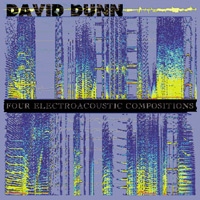David Dunn's Four Electro-acoustic Compositions
in All Music Guide, August 2002

This album is the first major addition to David Dunn's discography since Innova's
double CD set "Music, Language and Environment" in 1996. There has
not been much of the composer to go around and these Four Electroacoustic Compositions
portray another side of his work.
The four pieces, all between 10 and 15 minutes in length, date from the '80s
and '90s. Some had been previously available on compilation albums. The focus
is kept on the harshness of analog synthesizers, even though the sounds are
processed digitally and most of the music has been obtained through the use
of computer algorithms.
Central to the overall sound of the album is "Wildflowers" (1994),
best described as a retro-futuristic extravaganza. For its materials it goes
back to the early days of electronics, evoking the raw power (and migraines)
of Stockhausen and Xenakis electronic music by way of Herbert Braun's first
experiments with computer music. That sound of filtered sine waves and processed
square waves permeates the other pieces too.
"...With Zitterings of Flight Released" (1993), dedicated to composer
and teacher Kenneth Gaburo, then recently deceased, surfs the crest of the same
analog/digital wave with better (i.e. less ear-straining) results.
"Ennoia 2" (1999) uses time-domain synthesis algorithms created by
Arun Chandra's Wigout program. The music takes the form of an evolving soundscape
of filtered sine waves.
"Simulation 1: Sonic Mirror" (1986) is the only piece keeping ties
with Dunn's previous environmental concerns. Here, the naturally occurring sound
events of an outdoor environment are synthesized and transformed by computers
following variables taken from the environment. The listener is oblivious to
the cybernetics in play but the complex results are fascinating (and the original
sound events remain audible in the background).



